Abstract
Three hundred and thirty six forensic necropsy specimens of large bowel were examined in order to identify subject related variables that independently predicted the following adenoma characteristics: presence, size (largest), multiplicity and high grade dysplasia. The variables were age, gender, body mass index, race (European origin versus Maori/Polynesian) and presence of hyperplastic (metaplastic) polyp(s). Subjects included 303 New Zealanders of European origin (M = 185, F = 118) yielding 149 adenomas and 251 hyperplastic polyps and 33 Maori/Polynesians (M = 25, F = 8) yielding five adenomas and one hyperplastic polyp. Independent predictors of adenoma presence as determined by regression analysis were age (p = 0.0001), presence of hyperplastic polyps (p = 0.0001) and male gender (p = 0.05). Models were poor at explaining variation in size, multiplicity, and dysplasia. Larger adenomas occurred more frequently in subjects with multiple adenomas (p = 0.03) and multiple adenomas were probably associated with hyperplastic polyps (p = 0.09) and male gender (p = 0.09) in Europeans. High grade dysplasia was more frequent in women (p = 0.05) and possibly in subjects with hyperplastic polyps (p = 0.2). Body mass index and ethnicity did not predict any adenoma characteristics, but hyperplastic polyp prevalence was influenced by European origin (p = 0.04) and to a lesser extent by body mass index (p = 0.08) as well as presence of adenoma (p = 0.0002) and age ( = 0.005). The association of hyperplastic polyp with presence, multiplicity but not size of adenoma and with a high risk group for colorectal cancer (New Zealanders of European origin) suggests that the hyperplastic polyp serves as a marker for a factor which influences neoplastic evolution at the stages of initiation/transformation but not promotion. Fifty nine per cent of individuals with adenoma(s) did not have hyperplastic polyp(s) emphasising that the last would serve only as a marker of populations and not individuals at high risk of bowel cancer. Low intracolonic butyrate may be the factor linking the expression of the two types of polyp.
Full text
PDF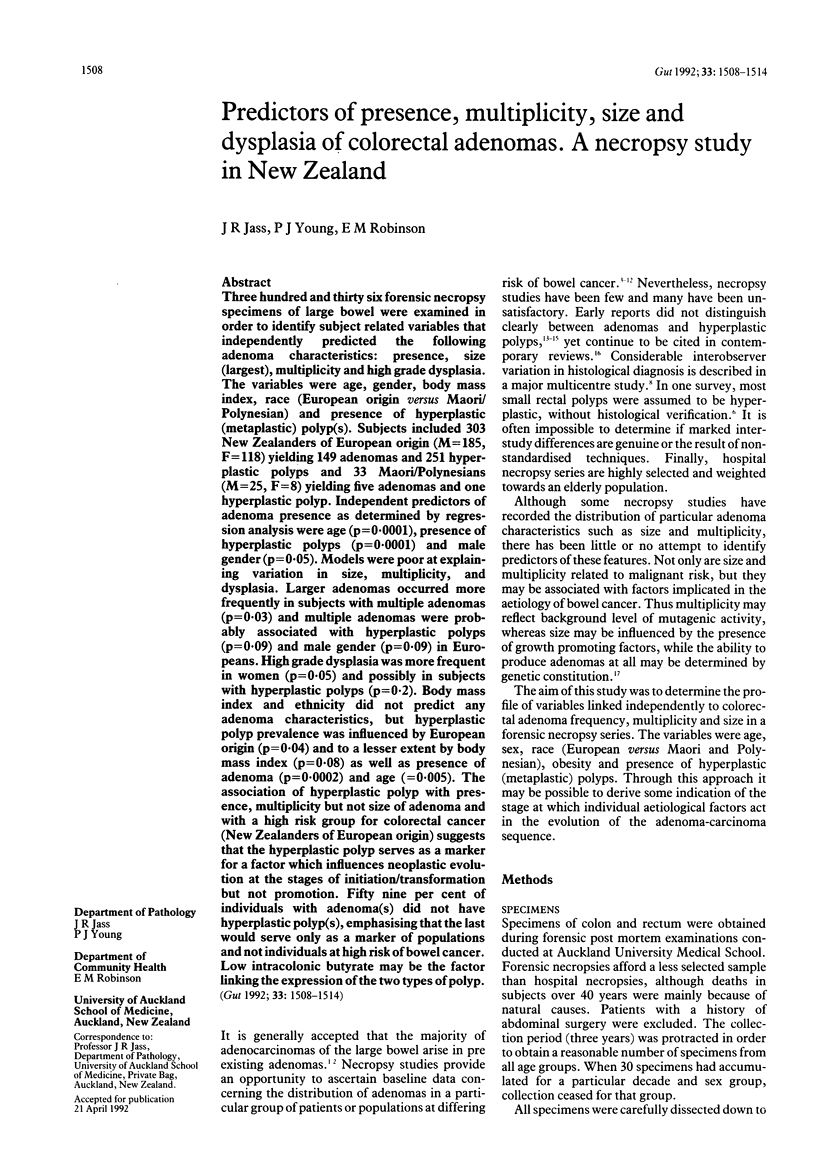
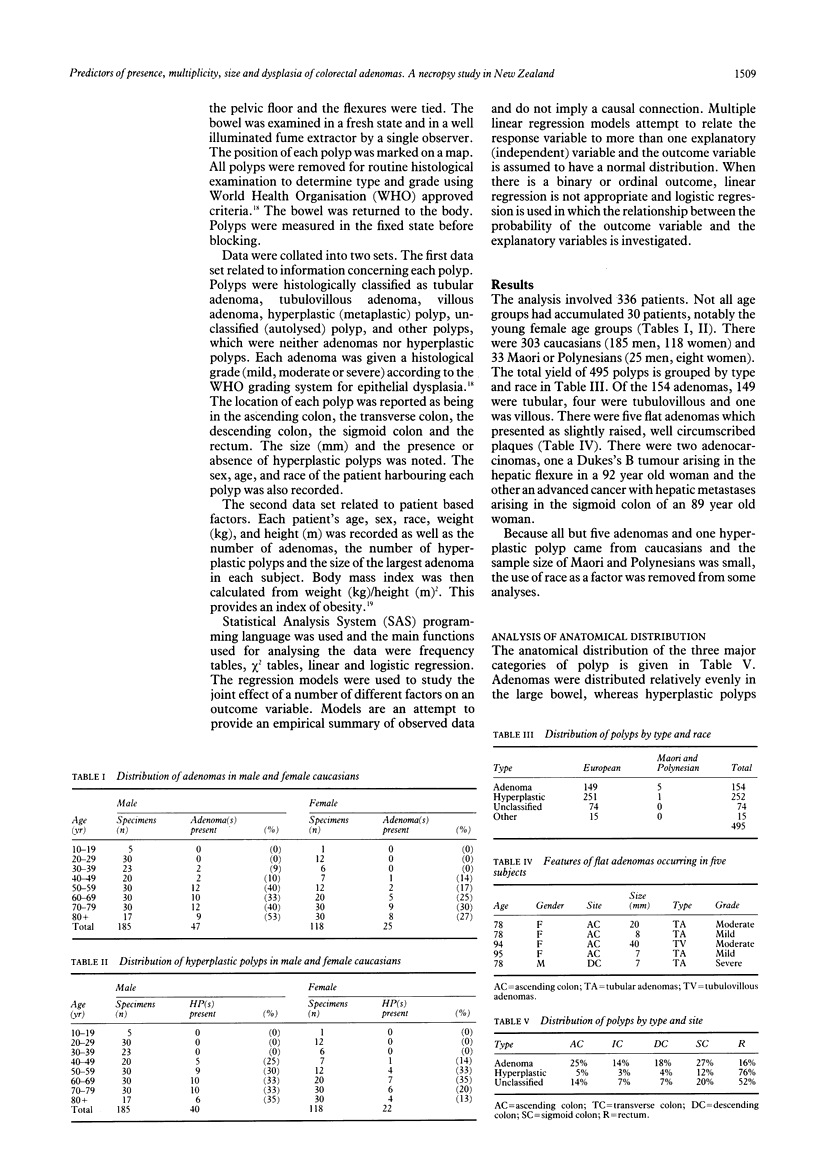

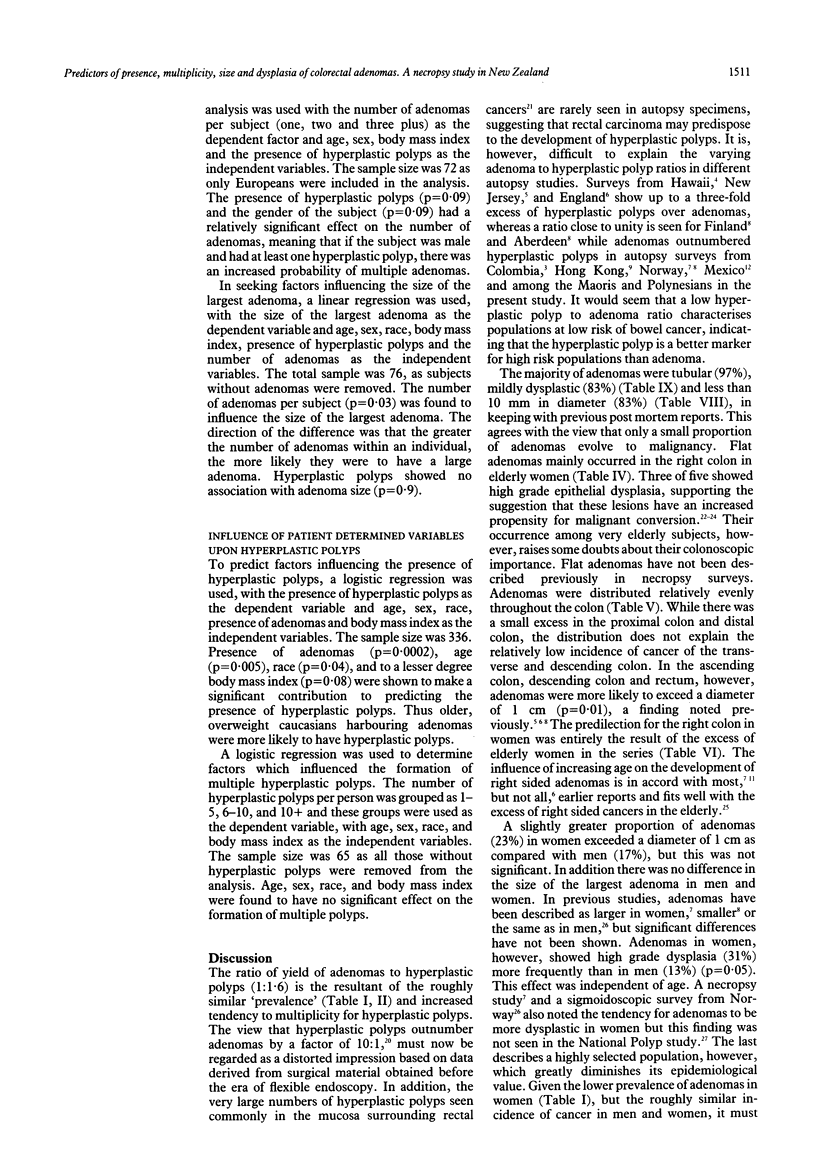

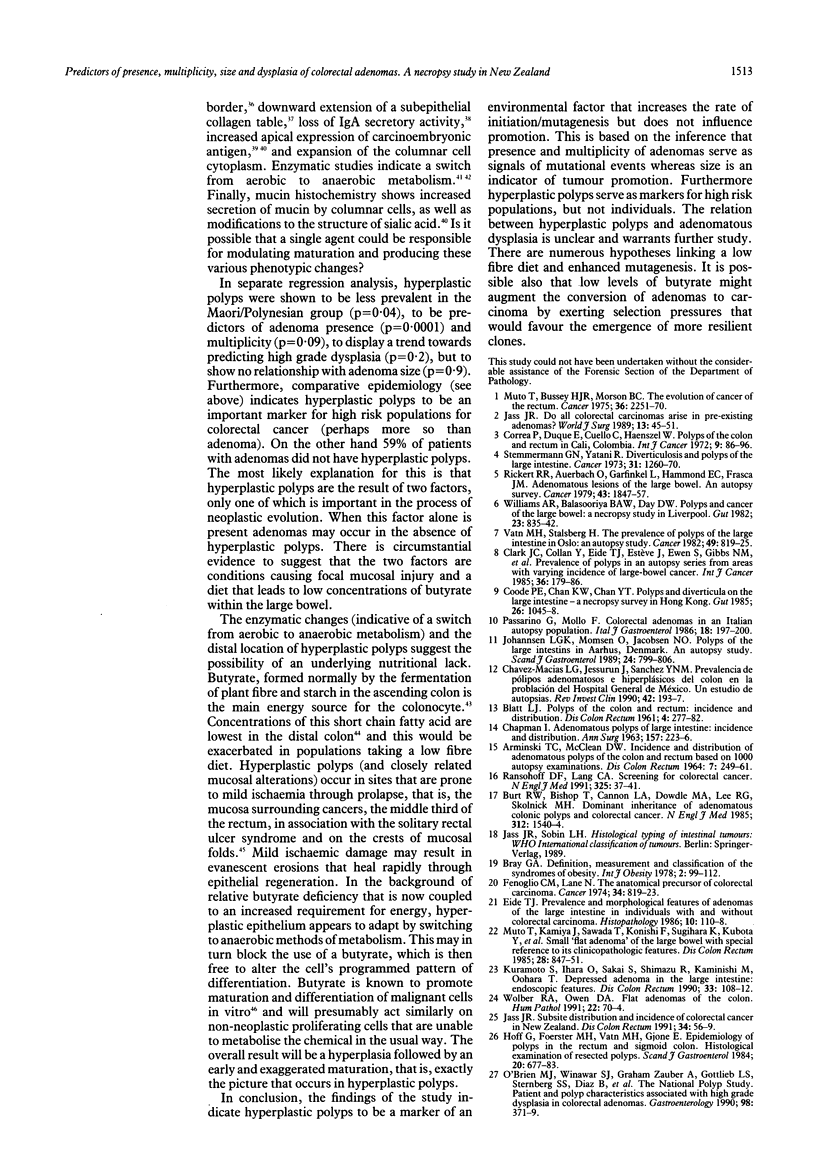
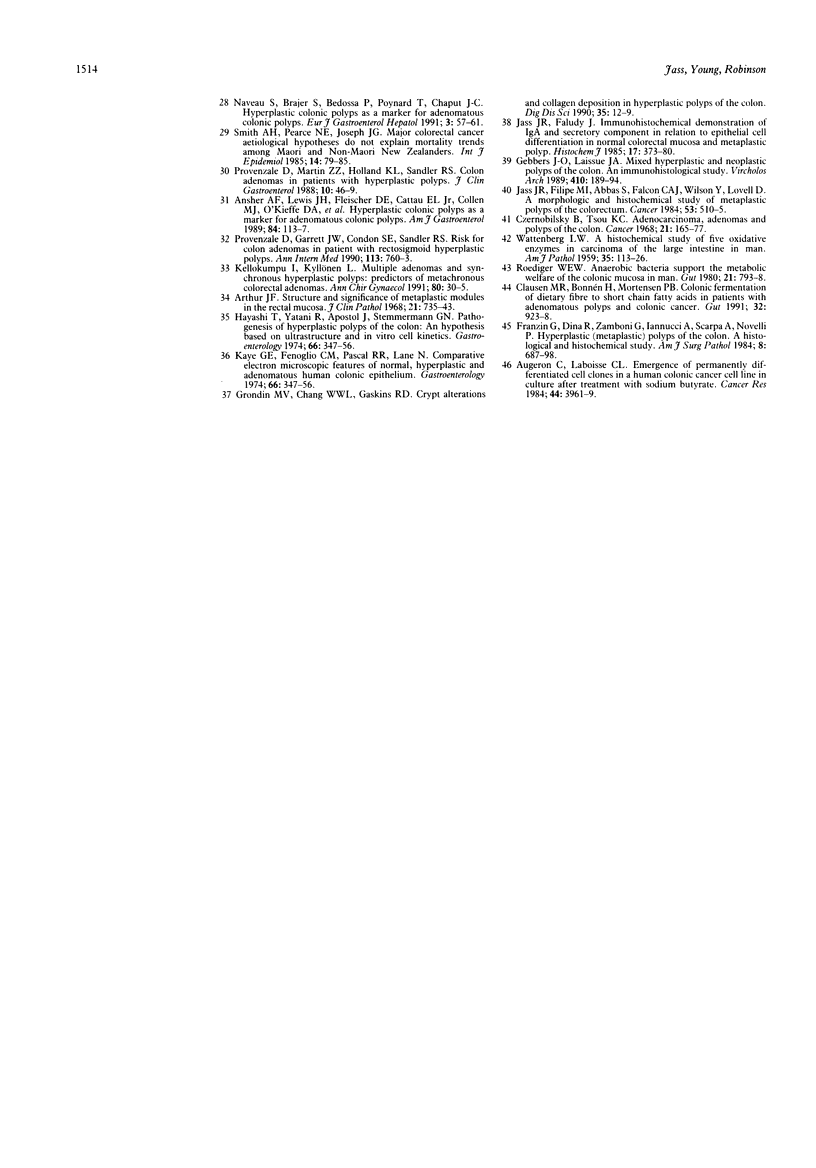
Selected References
These references are in PubMed. This may not be the complete list of references from this article.
- ARMINSKI T. C., MCLEAN D. W. INCIDENCE AND DISTRIBUTION OF ADENOMATOUS POLYPS OF THE COLON AND RECTUM BASED ON 1,000 AUTOPSY EXAMINATIONS. Dis Colon Rectum. 1964 Jul-Aug;7:249–261. doi: 10.1007/BF02630528. [DOI] [PubMed] [Google Scholar]
- Ansher A. F., Lewis J. H., Fleischer D. E., Cattau E. L., Jr, Collen M. J., O'Kieffe D. A., Korman L. Y., Benjamin S. B. Hyperplastic colonic polyps as a marker for adenomatous colonic polyps. Am J Gastroenterol. 1989 Feb;84(2):113–117. [PubMed] [Google Scholar]
- Arthur J. F. Structure and significance of metaplastic nodules in the rectal mucosa. J Clin Pathol. 1968 Nov;21(6):735–743. doi: 10.1136/jcp.21.6.735. [DOI] [PMC free article] [PubMed] [Google Scholar]
- Augeron C., Laboisse C. L. Emergence of permanently differentiated cell clones in a human colonic cancer cell line in culture after treatment with sodium butyrate. Cancer Res. 1984 Sep;44(9):3961–3969. [PubMed] [Google Scholar]
- Bray G. A. Definition, measurement, and classification of the syndromes of obesity. Int J Obes. 1978;2(2):99–112. [PubMed] [Google Scholar]
- Burt R. W., Bishop D. T., Cannon L. A., Dowdle M. A., Lee R. G., Skolnick M. H. Dominant inheritance of adenomatous colonic polyps and colorectal cancer. N Engl J Med. 1985 Jun 13;312(24):1540–1544. doi: 10.1056/NEJM198506133122403. [DOI] [PubMed] [Google Scholar]
- CHAPMAN I. Adenomatous polypi of large intestine: incidence and distribution. Ann Surg. 1963 Feb;157:223–226. doi: 10.1097/00000658-196302000-00007. [DOI] [PMC free article] [PubMed] [Google Scholar]
- Chávez-Macías L. G., Jessurun J., Méndez Sánchez N. Prevalencia de pólipos adenomatosos e hiperplásicos del colon en la población del Hospital General de México. Un estudio de autopsias. Rev Invest Clin. 1990 Jul-Sep;42(3):193–197. [PubMed] [Google Scholar]
- Clark J. C., Collan Y., Eide T. J., Estève J., Ewen S., Gibbs N. M., Jensen O. M., Koskela E., MacLennan R., Simpson J. G. Prevalence of polyps in an autopsy series from areas with varying incidence of large-bowel cancer. Int J Cancer. 1985 Aug 15;36(2):179–186. doi: 10.1002/ijc.2910360209. [DOI] [PubMed] [Google Scholar]
- Clausen M. R., Bonnén H., Mortensen P. B. Colonic fermentation of dietary fibre to short chain fatty acids in patients with adenomatous polyps and colonic cancer. Gut. 1991 Aug;32(8):923–928. doi: 10.1136/gut.32.8.923. [DOI] [PMC free article] [PubMed] [Google Scholar]
- Coode P. E., Chan K. W., Chan Y. T. Polyps and diverticula of the large intestine: a necropsy survey in Hong Kong. Gut. 1985 Oct;26(10):1045–1048. doi: 10.1136/gut.26.10.1045. [DOI] [PMC free article] [PubMed] [Google Scholar]
- Correa P., Duque E., Cuello C., Haenszel W. Polyps of the colon and rectum in Cali, Colombia. Int J Cancer. 1972 Jan 15;9(1):86–96. doi: 10.1002/ijc.2910090111. [DOI] [PubMed] [Google Scholar]
- Czernobilsky B., Tsou K. C. Adenocarcinoma, adenomas and polyps of the colon. Histochemical study. Cancer. 1968 Feb;21(2):165–177. doi: 10.1002/1097-0142(196802)21:2<165::aid-cncr2820210202>3.0.co;2-e. [DOI] [PubMed] [Google Scholar]
- Fenoglio C. M., Lane N. The anatomical precursor of colorectal carcinoma. Cancer. 1974 Sep;34(3):suppl–suppl:823. doi: 10.1002/1097-0142(197409)34:3+<819::aid-cncr2820340706>3.0.co;2-s. [DOI] [PubMed] [Google Scholar]
- Frazin G., Zamboni G., Scarpa A., Dina R., Iannucci A., Novelli P. Hyperplastic (metaplastic) polyps of the colon. A histologic and histochemical study. Am J Surg Pathol. 1984 Sep;8(9):687–698. doi: 10.1097/00000478-198409000-00008. [DOI] [PubMed] [Google Scholar]
- Gebbers J. O., Laissue J. A. Mixed hyperplastic and neoplastic polyp of the colon. An immunohistological study. Virchows Arch A Pathol Anat Histopathol. 1986;410(3):189–194. doi: 10.1007/BF00710824. [DOI] [PubMed] [Google Scholar]
- Grondin M. V., Chang W. W., Gaskins R. D. Crypt alterations and collagen deposition in hyperplastic polyps of colorectum. Dig Dis Sci. 1990 Jan;35(1):12–19. doi: 10.1007/BF01537216. [DOI] [PubMed] [Google Scholar]
- Hayashi T., Yatani R., Apostol J., Stemmermann G. N. Pathogenesis of hyperplastic polyps of the colon: a hypothesis based on ultrastructure and in vitro cell kinetics. Gastroenterology. 1974 Mar;66(3):347–356. [PubMed] [Google Scholar]
- Hayashi T., Yatani R., Apostol J., Stemmermann G. N. Pathogenesis of hyperplastic polyps of the colon: a hypothesis based on ultrastructure and in vitro cell kinetics. Gastroenterology. 1974 Mar;66(3):347–356. [PubMed] [Google Scholar]
- Hoff G., Foerster A., Vatn M. H., Gjone E. Epidemiology of polyps in the rectum and sigmoid colon. Histological examination of resected polyps. Scand J Gastroenterol. 1985 Aug;20(6):677–683. doi: 10.3109/00365528509089194. [DOI] [PubMed] [Google Scholar]
- Jass J. R. Do all colorectal carcinomas arise in preexisting adenomas? World J Surg. 1989 Jan-Feb;13(1):45–51. doi: 10.1007/BF01671153. [DOI] [PubMed] [Google Scholar]
- Jass J. R., Faludy J. Immunohistochemical demonstration of IgA and secretory component in relation to epithelial cell differentiation in normal colorectal mucosa and metaplastic polyp: a semiquantitative study. Histochem J. 1985 Mar;17(3):373–380. doi: 10.1007/BF01004598. [DOI] [PubMed] [Google Scholar]
- Jass J. R., Filipe M. I., Abbas S., Falcon C. A., Wilson Y., Lovell D. A morphologic and histochemical study of metaplastic polyps of the colorectum. Cancer. 1984 Feb 1;53(3):510–515. doi: 10.1002/1097-0142(19840201)53:3<510::aid-cncr2820530324>3.0.co;2-o. [DOI] [PubMed] [Google Scholar]
- Jass J. R. Subsite distribution and incidence of colorectal cancer in New Zealand, 1974-1983. Dis Colon Rectum. 1991 Jan;34(1):56–59. doi: 10.1007/BF02050208. [DOI] [PubMed] [Google Scholar]
- Johannsen L. G., Momsen O., Jacobsen N. O. Polyps of the large intestine in Aarhus, Denmark. An autopsy study. Scand J Gastroenterol. 1989 Sep;24(7):799–806. doi: 10.3109/00365528909089217. [DOI] [PubMed] [Google Scholar]
- Kellokumpu I., Kyllönen L. Multiple adenomas and synchronous hyperplastic polyps as predictors of metachronous colorectal adenomas. Ann Chir Gynaecol. 1991;80(1):30–35. [PubMed] [Google Scholar]
- Kuramoto S., Ihara O., Sakai S., Shimazu R., Kaminishi M., Oohara T. Depressed adenoma in the large intestine. Endoscopic features. Dis Colon Rectum. 1990 Feb;33(2):108–112. doi: 10.1007/BF02055537. [DOI] [PubMed] [Google Scholar]
- Muto T., Bussey H. J., Morson B. C. The evolution of cancer of the colon and rectum. Cancer. 1975 Dec;36(6):2251–2270. doi: 10.1002/cncr.2820360944. [DOI] [PubMed] [Google Scholar]
- Muto T., Kamiya J., Sawada T., Konishi F., Sugihara K., Kubota Y., Adachi M., Agawa S., Saito Y., Morioka Y. Small "flat adenoma" of the large bowel with special reference to its clinicopathologic features. Dis Colon Rectum. 1985 Nov;28(11):847–851. doi: 10.1007/BF02555490. [DOI] [PubMed] [Google Scholar]
- O'Brien M. J., Winawer S. J., Zauber A. G., Gottlieb L. S., Sternberg S. S., Diaz B., Dickersin G. R., Ewing S., Geller S., Kasimian D. The National Polyp Study. Patient and polyp characteristics associated with high-grade dysplasia in colorectal adenomas. Gastroenterology. 1990 Feb;98(2):371–379. [PubMed] [Google Scholar]
- Provenzale D., Garrett J. W., Condon S. E., Sandler R. S. Risk for colon adenomas in patients with rectosigmoid hyperplastic polyps. Ann Intern Med. 1990 Nov 15;113(10):760–763. doi: 10.7326/0003-4819-113-10-760. [DOI] [PubMed] [Google Scholar]
- Provenzale D., Martin Z. Z., Holland K. L., Sandler R. S. Colon adenomas in patients with hyperplastic polyps. J Clin Gastroenterol. 1988 Feb;10(1):46–49. doi: 10.1097/00004836-198802000-00011. [DOI] [PubMed] [Google Scholar]
- Ransohoff D. F., Lang C. A. Screening for colorectal cancer. N Engl J Med. 1991 Jul 4;325(1):37–41. doi: 10.1056/NEJM199107043250107. [DOI] [PubMed] [Google Scholar]
- Rickert R. R., Auerbach O., Garfinkel L., Hammond E. C., Frasca J. M. Adenomatous lesions of the large bowel: an autopsy survey. Cancer. 1979 May;43(5):1847–1857. doi: 10.1002/1097-0142(197905)43:5<1847::aid-cncr2820430538>3.0.co;2-l. [DOI] [PubMed] [Google Scholar]
- Roediger W. E. Role of anaerobic bacteria in the metabolic welfare of the colonic mucosa in man. Gut. 1980 Sep;21(9):793–798. doi: 10.1136/gut.21.9.793. [DOI] [PMC free article] [PubMed] [Google Scholar]
- Smith A. H., Pearce N. E., Joseph J. G. Major colorectal cancer aetiological hypotheses do not explain mortality trends among Maori and non-Maori New Zealanders. Int J Epidemiol. 1985 Mar;14(1):79–85. doi: 10.1093/ije/14.1.79. [DOI] [PubMed] [Google Scholar]
- Stemmermann G. N., Yatani R. Diverticulosis and polyps of the large intestine. A necropsy study of Hawaii Japanese. Cancer. 1973 May;31(5):1260–1270. doi: 10.1002/1097-0142(197305)31:5<1260::aid-cncr2820310535>3.0.co;2-n. [DOI] [PubMed] [Google Scholar]
- Vatn M. H., Stalsberg H. The prevalence of polyps of the large intestine in Oslo: an autopsy study. Cancer. 1982 Feb 15;49(4):819–825. doi: 10.1002/1097-0142(19820215)49:4<819::aid-cncr2820490435>3.0.co;2-d. [DOI] [PubMed] [Google Scholar]
- WATTENBERG L. W. A histochemical study of five oxidative enzymes in carcinoma of the large intestine in man. Am J Pathol. 1959 Jan-Feb;35(1):113–137. [PMC free article] [PubMed] [Google Scholar]
- Williams A. R., Balasooriya B. A., Day D. W. Polyps and cancer of the large bowel: a necropsy study in Liverpool. Gut. 1982 Oct;23(10):835–842. doi: 10.1136/gut.23.10.835. [DOI] [PMC free article] [PubMed] [Google Scholar]
- Wolber R. A., Owen D. A. Flat adenomas of the colon. Hum Pathol. 1991 Jan;22(1):70–74. doi: 10.1016/0046-8177(91)90064-v. [DOI] [PubMed] [Google Scholar]


